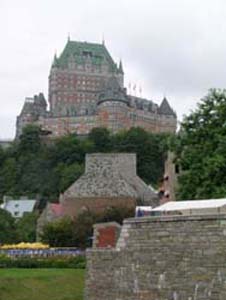
Destination Canada: October 6, 2004
Châteaux in Canada: the Great Railway Hotels
This webpage is a Talkin' Travel post-broadcast resource service for the listeners of the show. If you heard the segment on Canada's great railway hotels or are interested in travelling here, the information and links given below will help you plan an itinerary.
Destination Canada is a regular feature on Talkin' Travel (www.ttrn.com).
(With the exception of the initial one, all images are courtesy of Fairmont Hotels and Resorts.)
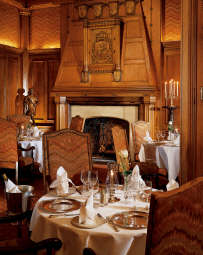
The Canadian Railway Romance
For many people — yours truly included — railways and railway travel still have a romantic appeal. I'm not talking mushy Hollywood romance (although trains have always been a convenient microcosm for that kind of sentiment); rather my reference is to a more comprehensive and historical sense of the term romantic.
Romance is from the French roman, meaning novel. Originally the roman was a long medieval narrative in prose or poetry that celebrated adventures and heroic exploits. These were stories that had mysterious or fascinating qualities, and more often than not a strange beauty that captivated the listener's imagination. Such tales were communicated orally and usually were based on real events. The stories also had a lyrical and sentimental quality to them, and because they contained themes of universal significance they resonated deeply with the listeners. Kind of like a distant train whistle on a dark night.
In Canada, the building of the transcontinental railway — linking east with west — was much more than a public building project; it was nation-building and the internalization in the Canadian consciousness of nationhood. It's story is a great Canadian romance.
Railways still play an important role in the transportation infrastructure of Canada and there are still some great railway excursions to be had in this country. (See the links further down this page.) And when you travel by train in Canada, you are travelling along some of the most poignant and historic routes in Canadian history.
To truly appreciate how the Canadian railways built this nation, you have only to hear the story of what in Canada is known as "The National Dream." (I'll get to that in a moment.) And if you stay in one of the great Canadian railway hotels, you will be part of the dream.
What are the great Canadian railway hotels?
The great railway age in Canada is not a thing of the past; you can experience it first hand in any of the great railway hotels that today are found across Canada. Each of these hotels is a destination, a landmark, and a thing of beauty in itself. Each of the hotels I am about to introduce you to is an archive of Canadian history and a romantic moment in time in the Canadian narrative. And while some are stunning geographical points of reference in the Canadian landscape, others serve as unifying focal points for the cities and communities in which they are found.
To Canadians, the names themselves evoke the Canadian "sense of place":
The Algonquin (St. Andrews, New Brunswick); Le Château Frontenac (Quebec City); Le Château Montebello (Montebello, Québec); The Queen Elizabeth (Montréal); The Château Laurier (Ottawa); The Royal York (Toronto); Château Lake Louise, Jasper Park Lodge, Banff Springs Hotel (Alberta); The Empress (Victoria, British Columbia) — to mention a few.
The above also represent a Canadian hop, skip, and jump from east to west, an ideal itinerary for an initiation into the Canadian experience.
The hotels were built primarily by two of Canada's great railway companies: the Canadian Pacific Railway and the Canadian National Railway. Each hotel is an architectural gem, and all are located in some of the most spectacular scenery you can imagine. (That was part of the reason some of them were built; to attract travellers to undiscovered areas in Canada.) And some of the hotels are located on the most historic real estate in Canada, an easy stroll from the impressive lobbies to the best of Canadian history, heritage, and culture.
These hotels also represent some of the best "value-added" accommodation you will find in Canada. There is no additional charge for the view, for the history that whispers throughout their corridors, for their strategic locations, for their unique architectural and aesthetic appeal, and for the Canadiana that each embodies.
Whether it is:
- a hotel that is also the largest log building in the world;
- a "Château style" edifice with granite walls and a copper roof;
- a hotel that is unofficially known as "The Third Chamber of Parliament" (where behind closed doors, politicians conduct the gloves off, straight-talking business of governing that is never seen on the news or in the House of Commons);
- a world-class golfing destination;
- a glorious structure in the equally glorious heart of the Canadian Rockies;
- an august and classical example of an urban hotel at the core of the commercial capital of Canada;
- a gracious memento of the British Empire (afternoon tea and all);
- or a favourite venue from the big band era,
each hotel is a tourist attraction in itself.
Have you got your bags packed?
(If you can't wait to read the rest of this material and want to get right to it, go to www.fairmont.ca. However, if you hang on a bit, you might pick up some information that will create a fuller context in which you can view these unique hotels. Hyperlinks below will take you on a cybertour of some of the hotels.)
The Fairmont Phenomenon
Today, each of these hotels is a member of the Fairmont Hotels and Resorts chain, a Canadian company, and the largest luxury hotel management company in North America. (Most people are surprised to learn that Fairmont also owns or manages famed hotels such as The Plaza in New York, the Acapulco Princess, The San Francisco Fairmont, and numerous other properties internationally.) Not bad for a bunch of 19th-century railroaders.)
As I have suggested above, there is a century of history embedded in the Fairmont group of properties that has a direct tie to the building of a railway through some of the most rugged and least populated terrain on the continent.
To make a long and fascinating story relatively short, the Canadian Pacific Railway (CPR) eventually also got into the sale of land and the settling of immigrants in Canada's West, the shipping business (passenger and cargo), mining and metallurgy, armaments and other material (during the Second World War), the telegraph business, the airline business (CPAir/Canadian Airlines International), oil and gas, corporate real estate, highway transportation, telecommunications, and the hotel business.
And before you could say "All aboard," the company whose first passenger train left Montréal on June 28, 1886 and arrived six days later in Port Moody, British Columbia, had become a very big deal.
Today, like a trumpet flourish, the name of each of the hotels in the chain is preceded by "Fairmont."
We Call Him "Sir John A."
When Canada came into being with Confederation in 1867, it was made up of four provinces: Nova Scotia, New Brunswick, Québec, and Ontario. The rest of the country from the Ontario border west was still under British control. The first prime minister of this new Dominion of Canada was John Alexander Macdonald; the principal creative mind behind the British North America Act that created Canada. A determined man and highly partisan politician, Macdonald was also an anglophile and consequently became a fervent Canadian nationalist. His national policy emphasized high tariffs on imports, especially those from the United States, in order to protect Canadian manufacturing. He was also not adverse to playing on anti-American feeling to achieve his goal of a strong and highly centralized form of government that held dominance over the provinces that previously had been British colonies. Macdonald's nationalistic feelings were primarily central and English-Canadian and he was always wary of what he saw as the threat of political and economic influences coming from the new republic to the south. It was indeed a North America true to British traditions that he aimed to achieve in his nation-building plans. (It is not surprising therefore that the British government made him Knight Commander of the Bath even before he became Canada's first prime minister.)
His government dominated Canadian politics for half a century and his principal preoccupation during his second administration was to create a unified Canada from coast to coast by means of building a transcontinental railway. Given the distances, the vast empty spaces to the west, and the almost impenetrable terrain; it was a formidable task. (It had to cross the Rockies and the Canadian Shield, the latter a huge area of ancient mountains, forest, and tundra that covers much of Canada like a shield with Hudson's Bay as its centre..) But Macdonald was no slacker, although he was a heavy drinker. He knew that all that westward ho activity south of the 49th parallel was a potential threat to Canadian sovereignty. He knew he had to get Canada's act together.
And the route he chose was a (very expensive) all-Canadian route across the Prairies and through the Rocky Mountains. In theory he could have built part of the route through the northern part of the American Midwest — many Canadians today travelling by car from east to west often take the "southern" route — but this railway was to be the Canadian transcontinental. Whether Macdonald actually realized it himself or articulated it, the building of such a railway would prove to be one of the first key steps in Canada's becoming an autonomous nation on the world stage.
And so a railway was built and market demand was built along with it. It was this "ribbon of steel" that led to the settlement of the Canadian west. And the completion of the railway was actually a precondition for British Columbia's joining the Canadian Confederation in 1871. Although it was eventually built by a private company, it was done so with great sums of public tax revenues. Longer than the first U.S. transcontinental railway by 1600 kilometres, this railway was also an enormous engineering feat. It would require another kind of leadership. And that's where Sir William comes in.
Sir William Cornelius Van Horne
Ironically, it would be a kid from Chelsea, Illinois (born 1843), a telegrapher at the age of 14 with the Illinois Central Railroad, and general superintendent of the Chicago, Milwaukee, and St. Paul Railroad by the age of 37 who would be the dreammaker of Macdonald's Canadian transcontinental railway. And he too would be knighted in the process. All he had to do was build a railway.
Railway history of course has always been about nation-building. (We're talking steam here.) By 1844 in the British Isles, the rapid expansion and promotion of railroads was called "The Mania." And as early as 1841, Canadians were beginning to become equally manic. Although our water routes were fortuitously well-designed by nature, roads were very rudimentary and of course the winter freeze-up didn't make it any easier to get from A to B.
Our system of canals was an effective way to transport people, goods, and troops but it would only be railroads that could extend real ownership of the land into new territories.
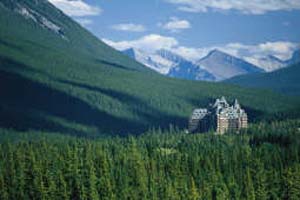
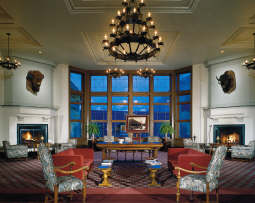
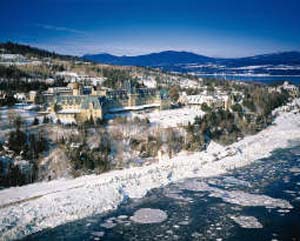
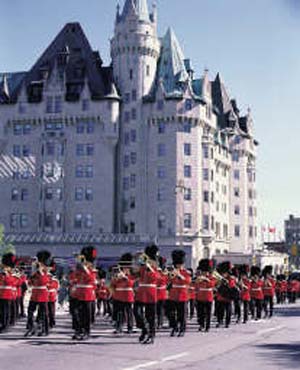
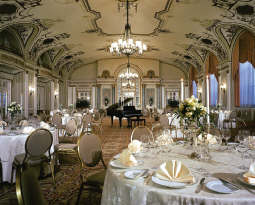
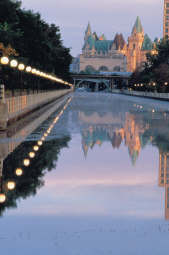
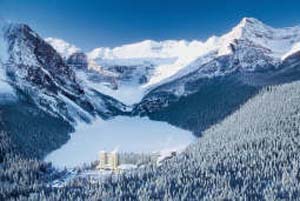
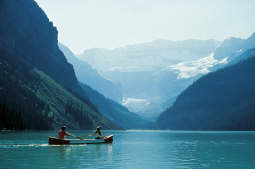
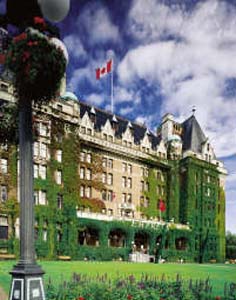
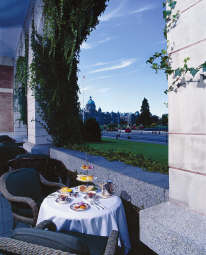
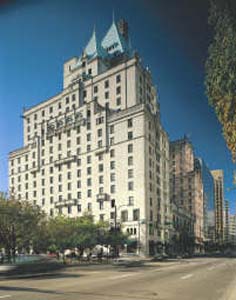
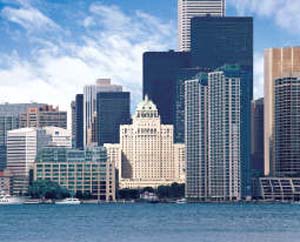
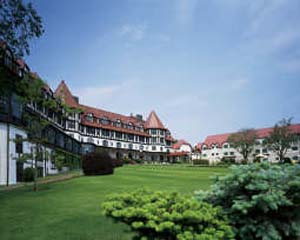
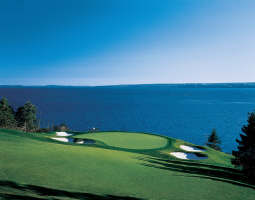
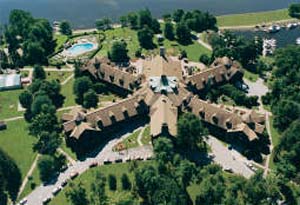
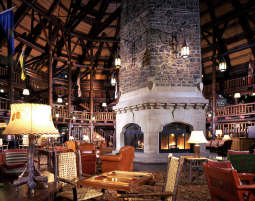
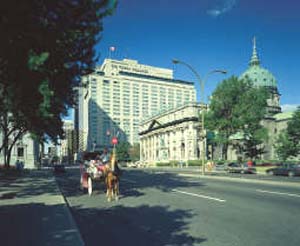
A number of smaller railroads were built in the east as well as some major ones: the Intercolonial Railway, the Great Western Railway, and the Grand Trunk Railway are examples. One of their objectives of course was to tap into traffic from the U.S. but also to open up the Canadian hinterland around the Great Lakes, which of course they did. The great railway rush created an exponential industry; creating a demand for fuel, iron, and steel for itself, as well as all the amenities required along the way; hotels of course being one of them. Most of all they provided jobs.
Van Horne was pretty much a jack of all trades. Today we would say he had lots of transferrable skills, perhaps even refer to him as a Renaissance Man. He certainly was a person who did not shy away from the grand and grandiose. His aesthetic tastes were as eclectic as his abilities; he owned many art treasures including an impressive collection of Japanese paintings and drawings. He obviously had an eye for architectural design and style, and as an amateur architect he even helped design two of the best-known of these hotels: Banff Springs Hotel and Québec's Château Frontenac. The former is a property that initially was far from the tourist route. Van Horne's response to that was, "If we can't export the scenery, we'll import the tourists." So he built a hotel to blend in with the natural environment as if found in situ. Like Macdonald, he was a visionary.
Sir William retired as president of the CPR in 1899 but he didn't sit around playing with model trains. He went on to build another national railroad, this time in Cuba. And when he died at the age of 72, the CPR paid tribute to him by stopping all operations for a day. Cuba held a day of mourning for him. And then the trains started to run again.
A Transcontinental Railway + Passengers = Hotels
In Canada, the historical tradition of lodging travellers is founded on two fundamental types of accommodation; the roadside inn and the urban hotel. As a nation being built through a natural wilderness of forests, lakes, and formidable terrain, the need for food and housing for the entrepreneurs and early leisure explorers followed the "King's Highway" or later, the railways. In the cities where trade and commerce in the abundant natural resources especially grew, the hotels often became as much public venues as city halls, railway stations often built in a similar style, and other official buildings. Growth was rapid, distances great, and the need for social interaction critical. Thus the hotel became far more than a temporary residence; it became a social institution in itself. And given the iconic history and traditions of many of the Fairmont hotels in Canada, many of these grand hotels continue to serve a purpose that goes beyond food and lodging.
Although the chain has now also built newer hotels (still in some of the most spectacular or strategic settings in Canada), most of the hotels are very much in a baronial style that embody our European roots. This is especially true of the hotels that are described as "château style."
Reminiscent But Indigenous Styles
Château style is distinctly Canadian although of course it pays homage to European grandeur. Some architecture aficionados also refer to the style as châteauesque. It was a style that was also adopted for public buildings in Canada in the 19th century, in part because the materials, such as hardwoods, granite, and limestone were readily available.
When you stand back and admire a Château Frontenac, a Château Lake Louise, and even an urban hotel like Toronto's Royal York, you will see a design that represents a free-flowing style (often asymetrical) in keeping with a new land where space was not limited. Backlit, the châteaux are extremely photogenic; their sculpted silhouettes, steep rooflines, high dormer windows, miscellaneous towers and turrets, and chimneys thrust skyward are a fanciful and romantic vision. However, they are also solid structures that make grand statements announcing clearly that we are here to stay; we are not just passing through.
Other hotels in the chain have a more manorial or seigneurial style which, like the château style, suggests entitlement and grandeur, but also the confidence and self-determination that is the essence of a nation that honours its roots while asserting at the same time its North American character. Although the château style derives from a number of sources — one can refer to French Renaissance, Gothic, Second Empire, Scottish baronial, Loire Valley, or neo-medieval — in the end, we just call it château style, as eclectic as Canada.
Time For A Visit
OK. Go for it.
In order to view all the hotels in the Fairmont chain, go to www.fairmont.ca.
Below are some of my favourites with a few facts about each that I hope will kindle your sense of the romantic. Each webpage will also give you access to the full history of each hotel or resort. Slideshows and other images also allow you to take a virtual tour of some of the most important and beautiful sites in Canada. Check out the value-added packages that each hotel offers and don't forget to factor in the truly "inclusive" value of these properties.
1. Le Château Frontenac, Québec City, Québec (www.fairmont.com/frontenac)
For most visitors, Le Château Frontenac is Québec City. Built by Van Horne over a century ago on Québec's high promontory overlooking the mighty St. Lawrence River, the hotel seems at first glance to be something out of a fantasy. However, it's imposing demeanor, castle-like architecture, and its views of this strategic historic location where France lost Nouvelle France to Britain symbolize the formidable drama and power of history.
2. Château Laurier, Ottawa, Ontario (www.fairmont.com/laurier)
This centrepiece of Canada's national capital manages to communicate opulence, dignity, charm, history, and continuity without appearing self-indulgent or excessive. Like so many in the Fairmont chain, it is in many ways a public venue where guests, locals, and tourists mingle. At the same time, it is where visiting royalty, celebrities, heads of state, and high-ranking politicians stay and work. There are many stories in the Château Laurier. If you can find it, the book Meet Me At the Château by Joan Rankin is a terrific read. The book tells the inside story of a hotel in which Canadian political and social history are part of the amenities. Often referred to as "the gateway to the nation's capital," the Château is at the heart of this elegant capital city and within walking distance of Parliament, key historical sites, and some of the most important art galleries and museums in Canada.
3. Banff Springs Hotel, Banff, Alberta (www.fairmont.com/banffsprings)
Banff Springs is a complete destination in all seasons, and a crystal-clear window on the Canadian Rockies. In addition to the other inclusive amenities I have suggested, here you also get world-class skiing, golf, wilderness activities, and elk eating on the front lawn. A natural spa with hot springs nearby, this is one of the best examples of Van Horne's goal of bringing the tourists to the scenery, because there is no way you can bring these breathaking views home in your backpack.
4. Château Lake Louise (www.fairmont.com/lakelouise)
The Fairmont promotional material for these Alberta properties calls them "Legends of the Canadian Rockies." The term legend is quite appropriate given the railway history that goes with them. When the CPR surveyor Tom Wilson wrote in his diary, "As God is my judge, I never in all my explorations saw such a matchless scene," he expressed the awe that first-time visitors to Lake Louise still experience today. Have you ever had the kind of moment when the beauty is so overwelming that you literally have difficulty believing your eyes? Well that's Lake Louise. Named after Queen Victoria's daughter, this resort is indeed majestic. From a writer's point of view, it is an experience that tests your mettle as a wordsmith. Describing it is a major challenge.
5. The Empress Hotel (www.fairmont.com/empress)
This property underscores the British in British Columbia. Tradition, empire-building, and colonial history are themes that are written all over the place. The setting of course is marvellous and simply lots of fun. The Empress is the perfect location for sitting quietly over tea (or perhaps in the Bengal Lounge) and reading Paul Scott's The Raj Quartet, Rohinton Mistray's A Fine Balance, or Vikram Seth's A Suitable Boy. As I said to the Duchess just last week, "It's all quite delightful."
6. Le Manoir Richelieu (www.fairmont.com/richelieu)
There is something very unpredictable about the Manoir. It's not just its sudden appearance as you come upon it driving along the north shore of the St. Lawrence. It's the almost incongruous setting of such a grand property in a pastoral landscape very much off the beaten track (but quite accessible). Would you have thought golf and whale-watching go together? This is poetic Québécois countryside (the region of Charlevoix). It has also been a favourite fishing destination (salmon) for quite some time — since 1761.
7. The Royal York Hotel (www.fairmont.com/royalyork)
A landmark around which the city of Toronto has grown, the Royal York is also right across the street from Union Station, one of the most impressive and classic railway stations in Canada. Both are reminiscent of the great railway age. Like so many of these hotels, the interiors of the Royal York are magnificent: hand-painted ceilings, lofty pillars, classic furnishings, and chandeliers. Although a previous historic hotel stood on this spot near the waterfront, The Canadian Pacific Railway began construction on "the largest hotel in the British Commonwealth" in 1927, and when it opened it was also the tallest building in the Commonwealth. It was luxury and innovation; each of the 1048 rooms had radios and private bathtubs or showers, not to mention a 12-bed hospital, library, concert hall with a 50-ton pipe organ, a glass-enclosed roof garden, a bakery, its own golf course, and copper wiring.
8. Hotel Vancouver (www.fairmont.com/hotelvancouver)
This hotel was opened in May 1939 just in time for the historic visit of King George VI and Queen Elizabeth (the Queen Mum). Their visit was especially significant as they were the first reigning monarchs to visit Canada. The visit of course was a "promotional tour" to rally support for the war and indeed their presence on Canadian soil did encourage many people to support Britain. Their tour was also significant because they crossed the country from east to west by train, stopping en route at many of the hotels mentioned here.
9. Le Reine Elizabeth (www.fairmont.com/queenelizabeth)
One of the later railway hotels (1958), the Queen Elizabeth is situated atop Montréal's extensive underground city which includes the gare centrale/VIA Rail passenger train station. It is also home to the oldest private club in Canada, the Beaver Club (founded in 1758). Like many of these hotels, the Queen Elizabeth was also a favourite and frequent stage for world-class entertainers such as Montreal-born Oscar Peterson, Tony Bennett, Liberace, Carol Channing, and Harry Belafonte. The hotel was also a political stage for John Lennon and Yoko Ono. It was here that they held their famous "Bed-In for Peace" in 1969 (suite 1742) and where they composed "Give Peace A Chance." The celebrity guest list is a who's who of The Queen Elizabeth is also right next door to the impressive Marie-Reine-du-Monde cathedral, another landmark in Montréal.
10. Jasper Park Lodge (www.fairmont.com/jasper)
One of the "Legends of the Canadian Rockies," this 903-acre resort began as an eight-bungalow wilderness retreat at the turn of the (20th) century. On the shores of Lac Beauvert and in the middle of the 4200-square mile Jasper National Park, it is especially known for its winter activities and its internationally acclaimed Stanley Thompson-designed golf course. "They" have all been here too of course: Marilyn Monroe, Bing Crosby, John Travolta, the Dixie Chicks, Bill Gates, the Rockefellers, the Kennedys, Sir Arthur Conan Doyle, yours truly... oh and Queen Elizabeth. If you saw the films River of No Return, The Far Country, or The Emperor Waltz, you too visited Jasper Park Lodge.
11. Le Château Montebello (www.fairmont.com/montebello)
The largest log building in the world (a cedar château), Le Château Montebello was built in 1930 and is still a construction marvel. (It only took four months to build, and to begin construction the crew first built a spur line from the nearby Canadian Pacific Railway.) It was Harold Saddlemire, a Swiss-American, who conceived of what he called "Lucerne-in-Québec"; this is château style à la suisse. For 40 years it was a private retreat for the Seigniory Club, whose members included such dignitaries as Canadian Prime Minister (and Nobel Peace Prize Award-winner) Lester B. Pearson, and Prince Rainier and Princess Grace of Monaco. It is built on the site of what in the 17th-century was (during the French regime in North America) a seigneurial estate acquired in 1674 from the West Indies Company by Bishop Laval, the first bishop of Québec and a name you will hear throughout Québec.As the site of numerous historic international political conferences, this not-so-little log lodge has hosted important political figures such as Ronald Reagan, Margaret Thatcher, François Mitterand, and of course Canada's charismatic Pierre Elliott Trudeau.
12. The Algonquin (www.fairmont.com/algonquin)
Do you prefer your golf with a little history? Then the Algonquin is your kind of resort. This is Canada's first seaside resort town and a quintessential Maritime province experience. In the loyalist town of St. Andrews by-the-ea in New Brunswick (a National Historic District), it was originally an enterprise of the St. Andrew's Land Company and established (by wealthy U.S. businessmen) in 1883. A North American-style spa resort, guests arrived (of course) by train and the property eventually came under the ownership of the Canadian Pacific Railway. On the shores of Passamaquoddy Bay in the Bay of Fundy, it is golf heaven. And because of their sensitive seaside location , the Algonquin courses are role models of environmentally-friendly golf course management. A full services and great getaway destination, the Algonquin is not just for golfers however. One of the most spectacular "hands-across-the-border" sites for Canadian and American visitors especially, the Algonquin is at the heart of Canadian history.
Want To Travel Across Canada By Train?
VIA Rail, Canada's national railway passenger service has a new one-stop-shopping website. For more information on the famous railway trips in Canada and on IA packages, go to www.viarail.ca/package
The private company Rocky Mountaineer Railtours (www.rockymountaineer.com) is also an excellent resource.
Life in a Canadian Château
The Château Laurier in Ottawa is a personal favourite of mine. It is also a great example of the hotel as more than just a place to sleep and eat. And it is one of the best examples of how these hotels have played a very significant role in the shaping of Canadian life.
Joan Rankin's book Meet Me At the Château tells it all. In the book she demonstrates how such a hotel is a living entity in itself and she includes some great Canadian hotel anecdotes. Here are some examples.
Ottawa's premier hotel was commissioned by American-born Charles Melville Hays, General Manager of the Grand Trunk Pacific Railway of Canada. Unfortunately Hays never saw his dream to completion; he was one of the many who died in the Titanic disaster. Memorial services were held for him in London and Montreal. The entire Grand Trunk system (railway and steamship) throughout Canada, Britain, and the United States came to a complete halt for five minutes in tribute to Hays.
Sir Wilfrid Laurier remains one of Canada's most respected prime ministers. Elected in 1896, he is still known for his moderate liberalism. The Grand Trunk (then owner of the Château) commissioned a marble bust of him for the lobby. (You can still see it today). Laurier however was not impressed. He wasn't happy with the nose which he saw during a private viewing. The bust had been dropped, the nose chipped, and repaired badly. He left the hotel rather upset but still was the first person to sign the hotel's register.
Typical of hotels of the early 1900s, the Château had budget-minded dormitories for traveling salespeople, one for men and five for women. No private baths but the conveniences were just down the hall.
The Château was the spot for coming out balls. (These were debutantes. Funny how language changes according to contemporary values.) Lavish receptions took place in the ballroom in the presence of the Governor General and his wife.
In 1916 Canadian Prime Minister Sir Robert Borden was given a magnificent reception at the Château when he returned from England where he attended a meeting of the British Cabinet. The occasion was precedent-setting because never before had a Canadian politician been received on an equal footing with British cabinet ministers. It may sound a bit strange today, but Canada was seen to be coming of age.
The Château was one of the first sites for a radio station Canada and continued over the years to be a broadcasting centre. In 1927, the country celebrated its Diamond Jubilee with a radio broadcast from the Château, also carried live by WWJ in Detroit for the benefit of American listeners. The inaugural concert of the Parliament's Peace Tower 53-bell carillon was also carried live on CKCH (the original call letters).
This story may be a bit apocryphal but ... when a new a east wing was added to the Château with a new shiny copper roof (to match the other roof which in turn was a reflection of the roofs of the Parliament Buildings nearby), the aging of the roof (so that it turned green faster) was allegedly speeded up by a contractor who had his workers pee in a bucket (when they had occasion or need to do so) and the urine was used to give the oxidization process a head start.
The four foot-high windows over the front doors of the Château are from Tiffanys.
When Roy Rogers and Dale Evans checked in they were whisked to their rooms in an elevator reserved for their exclusive use. Other celebrities (e.g. Haile Selassie) got the same treatment. No mention is made of Trigger.
The original Grill Room on Thursday was usually filled to overflowing. People came for the Thursday special: chicken pot pie!
With the 1929 stock market crash, Ottawa and the Château created a winter carnival to stimulate the economy. It was advertised far and wide. Today Ottawa's Winterlude is a major tourist attraction and hometown event.
The First Imperial Economic Conference to be held outside London, took place in Ottawa and of course all the delegates ("and their wives") were accommodated at the Château.
The Art Deco swimming pool (you can still see it and swim in it today ... and must) was part of a complex hydrotherapy indoor spa in the Château.
One of the early managers, a certain Mr. Aylett, was renowned for being a tough but very competent and respected manager. Staff and even some guests were somewhat intimidated by him. He had standards and expected everyone to abide by them. One frequent guest who unfortunately was bent on suicide checked out of the hotel and took cheaper accommodations because apparently he feared Mr. Aylett's displeasure. Another prominent citizen had taken a lady of the night to his room. (The lobby staff knew them all ... the ladies I mean ... and only because it was their job to know who was coming and going.) When the night clerk telephoned his room and advised the gentleman that "visiting hours" were over but the lady stayed on, the clerk went to the room and opened the door slightly with a master key. From inside was heard, "In the name of the Father, Son and Holy Ghost, she'll be right out." The standards of Mr. Aylett lived on.
During the Second World War, the Château was the site of many secret military conferences. Important military and industrial leaders quietly entered the hotel from a tunnel connecting the hotel to the train station across the street.
When Winston Churchill visited Ottawa (and stayed at the Château) he gave his famous address to the joint session of the House of Commons and the Senate. In response to the Vichy French officer who predicted that England would "have her neck wrung like a chicken," Churchill replied (carried live on radio) "Some chicken ... some neck!"
One of the most prominent radio announcers during the Second World War who broadcast from the Château was known as the "voice of doom" because in his deep baritone he relayed the terrible news from correspondents overseas. Canadians also knew him as Lorne Greene, later Pa Cartwright on a ranch called Bonanza.
In 1987 the Château management held an "amnesty" during which all materials that had been, shall we say "borrowed" from the Château, could be returned. Objects such as a Sèvres china urn and matching candlesticks, a soda water siphon, china beer steins bearing the hotel's motif, and a carved mahogany beaver were some of the items returned.
There was one mysterious murder that occurred at the hotel. The wife was charged but later acquitted. The number was taken off the door, the room converted to a suite, and occupied for a long time by the Québec government.
During Canada's centennial celebrations in 1967, 54 heads of state or their representatives paid visits to Ottawa, most of them staying of course at the Château.
Many prominent people actually lived at the hotel, Pierre Trudeau being one of them (before his election as prime minister and before his marriage). One of these was the world-famous photographer Yousuf Karsh, known professionally as "Karsh of Ottawa." His portraits of world leaders and personalities such as Einstein, Martin Luther King Jr., Eleanor Roosevelt, Ernest Hemingway, Audrey Hepburn, Mother Teresa are now legendary images. One of his most famous is that of a defiant Churchill. This image came to represent the courage of Britain during the war. During the photo shoot in Karsh's studio in the Château, Churchill was posing with his customary cigar in hand. At the last moment, Karsh stepped forward and removed the cigar from the great man's hand. Needless to say, Churchill was not pleased and put on his very best scowl.
When Karsh left Ottawa and moved to Boston, he left behind as a gift to the Château, copies of his books and photographs. These can still be seen today and are very much part of the living history of the Château Laurier.